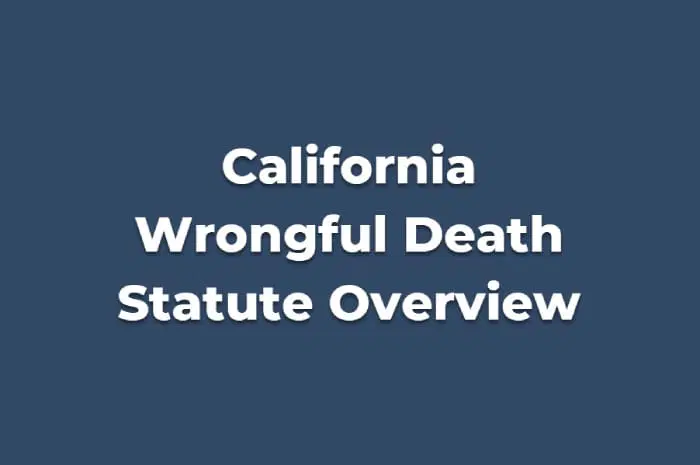
Common CA Wrongful Death Statute Misconceptions with Examples
Legally reviewed by: Jessica Anvar Stotz, JD, MBA
The loss of a loved one is always tragic. When a loved one dies due to the wrongful act or negligence of another party, families in California may pursue civil lawsuits against those responsible.
This is known as a wrongful death claim. However, these claims must be filed within the state’s statute of limitations, a strict 2 year deadline.
Many Californians misunderstand the specifics of how and when this time limit is calculated and applied. In this article, we will clarify some common misconceptions to help families make informed legal decisions.
Key Takeaways
Some most important points to remember about the California wrongful death statute are:
- Wrongful death claims have a 2-year statute in California, but other limits apply for survival actions.
- The clock starts at the discovery of wrongdoing, not necessarily the date of death.
- The deadline can be extended by tolling provisions.
- No statute of limitations ever applies to murder charges.
- Exceptions exist to extend the time limit for minors.
16 Misconceptions Californians Have About the Wrongful Death Statute
- Thinking it’s 1 year. The statute of limitations for filing a wrongful death lawsuit in California is actually 2 years from the date of death.
- Believing the clock starts at death. The 2-year time limit begins to run on the date the plaintiff discovers, or through reasonable diligence should have discovered, the wrongful act that caused the death.
- Assuming the deadline is exact. The statute can be tolled (paused) if the defendant is out of state or concealing facts. So the effective time limit may be longer.
- Thinking it applies to murder. There is no statute of limitations for murder charges, including those that qualify as “wrongful death.” Only civil wrongful death lawsuits are subject to the 2-year statute.
- If the wrongful death was caused by medical malpractice, the statute of limitations may be extended to three years from the date of the injury or one year from the date the injury was discovered, whichever comes first.
- If the wrongful death was caused by governmental negligence, there are specific procedural requirements and shorter deadlines for filing a claim.
- Confusing wrongful death with a survival action. A survival action that the deceased could have filed has a different statute – it must be filed within the time limit for that underlying claim.
- Believing the statute restricts how long the case can last. The statute only limits when the lawsuit can be filed, not the length of the case once filed properly.
- Not realizing exceptions apply for minors. If the deceased has minor children, they have until age 26 to file a wrongful death claim in CA.
- Thinking the statute of limitations stops running once a lawsuit is filed. The statute only sets the deadline to file the initial claim. Once a wrongful death lawsuit is properly filed, it can proceed even if the 2-year limit expires.
- Assuming a probate claim for wrongful death has no time limit. There is a statute of limitations for creditor claims made during probate. Wrongful death claims filed through probate still must adhere to the 2-year limit.
- Believing the statute of limitations will be extended if they are still grieving. Unfortunately, exceptions for grief or emotional hardship are not grounds to pause or extend the statute of limitations.
- Failing to name all responsible parties before the deadline expires. California law prohibits adding new defendants after the statute of limitations has passed, even if discovery later uncovers additional liable parties.
- Waiting to file out of fear of litigation stress during grief. While emotional capacity affects other legal deadlines, wrongful death claims must be filed within 2 years regardless.
- Thinking partial compensation from one source stops the clock on additional claims. Settling with one party’s insurance company, for example, does not affect statutes of limitations against other defendants.
- Assuming all attorneys know the intricacies of wrongful death statutes of limitations. Due to complexities, it’s important to consult an attorney experienced and knowledgeable in wrongful death.
Example Scenarios of Misconceptions
1. Misconception: The clock starts at the date of death
John’s wife Mary died in a car accident caused by a defective vehicle part on March 1, 2022. John incorrectly assumed he had until March 1, 2024 to file his wrongful death lawsuit, thinking the 2-year limit starts on the date of death.
However, John did not discover the defective part was the cause until August 30, 2022 when the investigation report was released. The clock actually started ticking on the date John discovered the wrongful act that caused Mary’s death. So the statute of limitations runs out on August 30, 2024, not March 1, 2024.
2. Misconception: The deadline is exact
Juanita’s son Adam was killed in a workplace accident due to safety violations on January 5, 2020. The company owner, who is liable for Adam’s death, left California in June 2021 to temporarily live in Europe.
Juanita incorrectly thought she must absolutely file her wrongful death claim by January 5, 2022. However, the owner’s absence from the state paused the statute of limitations under California’s tolling provisions. So Juanita actually had more time beyond the original 2-year mark to file.
3. Misconception: Filing a claim stops the clock
Lisa filed a civil wrongful death lawsuit against the hospital within 2 years of her mother’s passing from medical malpractice. She incorrectly believed that filing the claim meant she no longer had to worry about statutes of limitations.
Later, new evidence revealed the device manufacturer was also liable. However, when Lisa tried to add the manufacturer as a defendant, she learned she was barred since the statute of limitations had expired. Filing the original lawsuit did not stop the clock.
Wrongful Death vs. Survival Actions
It’s important to understand the difference between a wrongful death lawsuit and a “survival action.” The latter is a separate claim that the deceased person could have filed for injuries had they survived.
Survival actions have their own statutes of limitations depending on the underlying issues. A wrongful death claim is specifically for the losses suffered by family members because of the death. Only wrongful death has the 2-year statute.
When the Clock Starts Ticking
The 2-year period for wrongful death claims begins when the plaintiff discovers, or reasonably could have discovered, the wrongful act causing death.
Unlike some states, the clock does not start automatically on the date of death in California. This is a key distinction many people misunderstand.
Exact Deadline vs. Tolling Provisions
While the statute sets 2 years as the deadline, this can be paused or “tolled” under certain conditions. For example, if a defendant leaves the state or conceals facts, the limitation period may be tolled until they return or the facts are uncovered. So the deadline is not always exact.
Criminal Murder vs. Civil Wrongful Death
There is no statute of limitations for filing criminal murder charges in CA, even when the killing would qualify as wrongful death. But civil wrongful death lawsuits do have the 2-year limit. This is an important distinction.
Exceptions for Minors
If the deceased person had surviving minor children, the time limit for the children to file a claim is extended to their 26th birthday. This provides additional protection for grieving families.
Variation Among States
The statute of limitations for wrongful death ranges from 1-4 years in different states. So California’s 2-year limit is on the shorter side nationally, underscoring the need for quick legal consultation.
Final Thoughts
Consulting a knowledgeable California attorney is crucial when pursuing a wrongful death claim, given the complexities involved.
While the grief over losing a loved one endures, legal recourse has a short finite window. Understanding California’s statute of limitations for wrongful death claims allows families to take action and seek accountability when the law allows. Contact LawLinq today for a free consultation.


